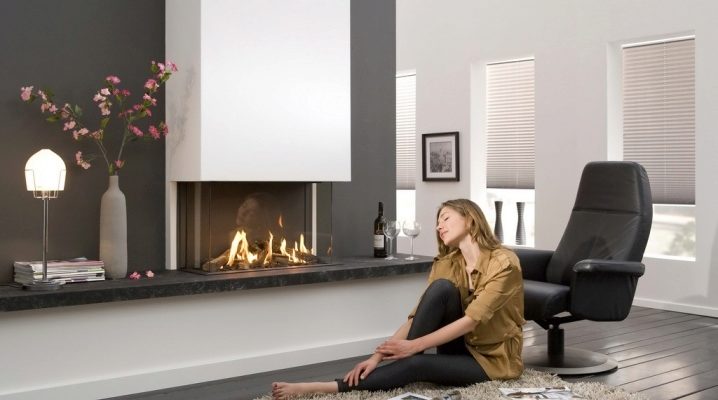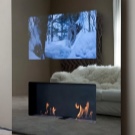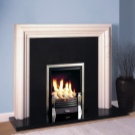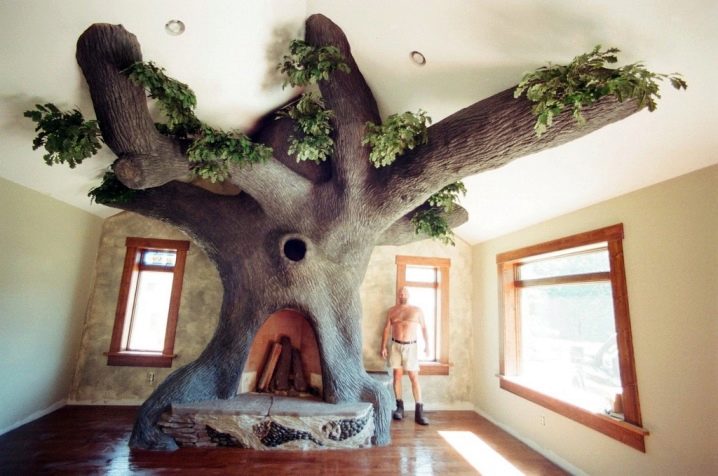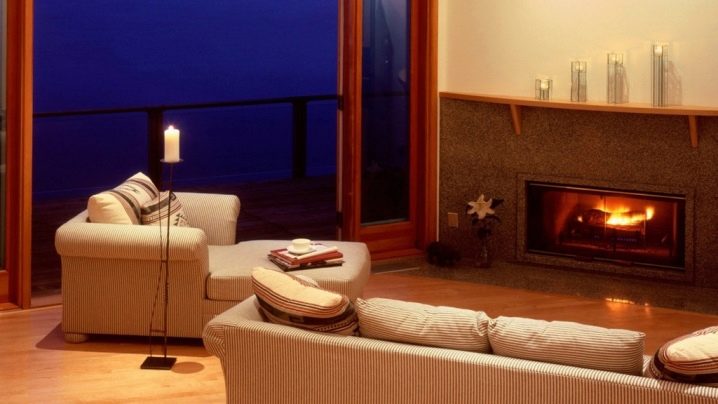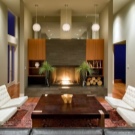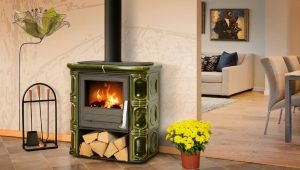How to make a fireplace with your own hands?
Today, many owners of country houses and apartments are thinking about their own handicraft of the fireplace. Such desires can pursue 2 goals: obtaining a main or auxiliary source of heating or additional interior decoration. Some people want to get both that and that at all. Of course, fireplaces can perform both of these functions, but in order for them to be long and safe to use, you need to know how different types of such heaters are arranged and how to construct them.
Design and principle of operation
Thanks to the development of technology, the modern range of fireplaces has become very diverse. Each of the varieties has its own characteristics regarding design, operating principle and thermal efficiency. Let's try to understand all these features.
Open
Open fireplaces are classified as classic. They are perfect fans of antiquity.The structure of such heaters is very simple: they have a fireplace portal that houses firewood, side and top decorative panels, and a chimney. Also, a special valve is necessarily present (it is called a view). This valve provides traction during combustion and protects the fireplace from the penetration of rain and snow.
The main advantage of such fireplaces is the relative simplicity of their arrangement. However, there are a lot of minuses. The main drawback of such models is the impossibility of arranging them in apartments, since there are no conditions for laying a chimney. In addition, these models have a high fire risk, because the coals from the logs can fall on the floor. Another flaw is poor adjustment of the intensity of combustion (only the viewer plays the role of a regulator, but it gives a minimum of possibilities).
Closed
By and large, this is the twin brother of an open model. It has a similar device and similar exterior design. But the key differences are still present. First of all, such a heater is equipped with a glass lid, which does not allow the embers to fall to the floor. Thus, closed models are safer.
In addition, the inside of the portal is equipped with special sensors that allow you to adjust the intensity of combustion. The heat consumption of such models is much lower (that is, most of the heat goes to heat the room, and does not go outside). The main disadvantage of closed fireplaces is the need to arrange a full-fledged chimney, because of which the installation of such heaters will not be able to afford the inhabitants of apartments.
Ekokamin
This is one of the latest models of fireplaces, suitable for those who want to get the most safe and environmentally friendly heater. Such models work on ethanol, and not on wood or coal. As a result, when burning, a minimum of carbon dioxide is emitted, there is a minimum clogging of the fireplace itself and the environment. In addition, the lack of the need to use firewood may appeal to anyone who seeks to protect nature.
Another important advantage of these models is their versatility. They can be installed both in private homes and in apartments. Moreover, ekokaminy always have a sophisticated design that allows you to decorate the interior. There is a variety in terms of size.If desired, a person can install both a large fireplace on the entire wall and a miniature analogue that serves exclusively as an element of decor.
Alcoholic
In fact, alcohol models are subspecies of ecocamines. Their main difference is the possibility of using a larger amount of fuel, which allows to fully heat the room. Like previous models, alcohol counterparts also have a beautiful design and can be installed both in apartments and in private homes.
Cassette
Variety of fireplaces, very similar to the classic closed models. Their highlight is that they are equipped with a retractable firebox, which is located in a special cassette. In other words, the basis of the heater is classical (there is a basement, a smoke outlet, a fireplace portal), but the fuel (wood, coal) is in a removable drawer. Such a device greatly simplifies the cleaning of the furnace: it is simply removed, cleaned from the ashes and washed. The ability to keep the firebox clean when the fireplace is not used significantly extends the life of the entire structure.
The main flaw in these models is the fairly large size and the need to equip a full-fledged chimney.Because of this, they can only install residents of private homes.
Steam
Another modern version of heaters. Its main advantage is the absence of a real flame, which makes the fireplace fireproof. Special electronics breaks down the liquid, forming a vapor. Special lighting imitates the burning of the flame, which makes such a fireplace an excellent interior decoration.
On gas
A very popular type of modern fireplaces. Such models are universal (suitable for both houses and apartments). They are equipped with special electrical sensors and a convenient control panel that allows you to adjust the intensity of combustion. Moreover, the supply and ignition of fuel is carried out by pressing a single button or turning the thermostat, and this greatly simplifies management.
In addition, gas fireplaces are equipped with various protective mechanisms. For example, the heater will turn off if it overturns. Also, there is a special combustion sensor that will stop the flow of gas if the fire suddenly goes out.
The only disadvantage of such fireplaces - a complex installation. Because of this, the future owners of such a heater almost always have to use the services of professional craftsmen, and these are additional material costs.
What other types of fireplaces?
In the modern market there are other options for heaters. In particular, it is possible to equip an all-electric fireplace that can heat one room. The decoration of such structures can be the lighting of plastic logs or embers, imitating burning. Fully electric fireplaces are suitable for heating a single room, but are not suitable for heating an entire apartment or house. Another disadvantage is the excessive consumption of electricity.
If you want to buy a fireplace, which will play only the role of decoration, then you can give preference to miniature varieties of alcohol or ecofirestones. Such models can be put on the table or window sills. They are perfect for creating a romantic atmosphere during dinner.
Training
When self-erecting the fireplace preparatory stage is considered extremely important. The success of the entire work and the subsequent operation of the heater depend on how it is executed. Let's find out what points should be paid attention to before starting to build a fireplace.
Choice of location
The selection of the area that will be set aside for the fireplace is the very first aspect of the preparation. Choosing the location of the heater, you should consider the type of future design, its potential power, the purpose of use. If you plan to build a classic version of the fireplace, you need to think in advance about how to equip the chimney. If you decide to install a gas fireplace, you need to consider the method of arranging the smoke pipes.
Also, air circulation plays a big role. Of course, free air should be present, but strong drafts are undesirable. For this reason, heaters are not recommended to be installed directly in front of windows that can be opened for ventilation.
If the installation of a portal inside walls is meant, the bearing capacity of the partitions should be taken into account. If there is a large room, the fireplace can be installed almost everywhere: in the center of the room, near the wall, in the corner. If the room for the fireplace is compact, it is recommended to install the heater in the corner, on the wall or inside it.
Drawing
The scheme according to which the fireplace will be created is your main assistant.That it will allow to adjust the entire process of work, so that the components fit perfectly on each other. Moreover, the well-defined dimensions of each part of the fireplace will protect against unforeseen difficulties at the assembly stage.
Since the creation of a drawing requires special skills, it is better to entrust this task to professionals. However, if you yourself have the necessary knowledge, you can draw a drawing without outside help. The main thing - take into account all the features of the room and the potential of your creation.
Materials and solutions
To create a fireplace yourself, you need to acquire the following materials:
- full-bodied bricks - their exact amount depends on the dimensions of the heater specified in the drawing;
- clean sand, having a grain size of up to one and a half millimeters (if you can’t find absolutely clean sand, you can take dirty and clean it - put it in water and insist, changing the water every day; cleaning takes place before the sand becomes clear);
- kiln clay for lining brick elements;
- cement (even ordinary Portland cement will fit);
- crushed stone to be used in the process of laying the foundation;
- reinforcing bars (approximately 20 units are needed);
- smoke damper (as a rule, a thin sheet of ordinary metal is suitable).
Accessories
As for tools and additional items, you will need:
- shovel, with the help of which the foundation pit will be pulled out;
- level to monitor the quality of the calculations;
- blade for the intake and application of cement;
- spatula, with the help of which the surface of the foundation and seams between bricks will be leveled
- wooden planks from which the formwork will be constructed.
Step by step instructions for this fireplace
After creating the drawing, choosing the location, procurement of all materials and tools, you can begin the process of construction. During operation, you must follow the instructions and follow all the rules. Only in this situation the work will be completed successfully, and the fireplace will be able to function.
Foundation and frame
The foundation of the future heater is done as follows:
- the excavation is first dug - its dimensions should exceed the size of the fireplace by 10-15 cm, and the depth should be 55-60 cm;
- the pit is filled with a 10-centimeter layer of crushed stone (the surface is necessarily leveled);
- after that, a formwork is constructed from the prepared boards (it is recommended to treat the inside of the formwork with resin in order to ensure proper tightness);
- then mixed with a solution of cement and sand (1: 3 ratio);
- the pit is filled with the resulting mixture;
- the surface of the foundation is leveled with a spatula;
- when the foundation begins to harden, reinforcing rods are driven into it (they will play the role of a fireplace "skeleton");
- the foundation is left for 7 days (this is the period required for its one hundred percent hardening).
Masonry
After preparing the foundation, the actual laying of the fireplace begins. In carrying out this work, ordering plays a key role. All brick elements should fit clearly on each other. The brick side that comes into contact with the reinforcing skeleton should not be in the cement mortar.
The first row fits over the mortar with the addition of cement. Laying bricks, you must constantly monitor the geometry of the structure. The walls should grow clearly vertically, while their horizontal surface should be flat. To control the level you need to use the appropriate tool.
To control the correctness of the consumption of bricks will help pre-made scheme. Spent areas can be crossed out with a pencil, so as not to be confused.
Arches
After completion of the basement we construct the firebox. He laid out in a similar pattern, but here you will need to pay close attention to its inner side. In particular, it is necessary to completely remove the protruding particles of the cement joint. The inner part of the fuel compartment must be flat.
Constructing the exhauster and channels, it is necessary to monitor the vertical structure. Here you also need to clean the inner surface. This measure is due to the fact that there should be a good streamline inside the chimney. It will provide proper traction and normal smoke output.
If you want to decorate the fireplace with an arch, you will need to take some additional steps. In particular, you will need to build a rectangular formwork that will hold the bricks until the seams freeze. The bricks should be placed as tightly as possible so that the forming pressure keeps them from falling. Due to the arc structure of the arch, voids may form between the seams.They should be filled with additional cement.
Registration and facing
After a complete calculation of the entire fireplace begins the most enjoyable part of the work - its external design. You can decorate your homemade heater with the help of various materials:
- marble;
- patterned ceramic tiles;
- decorative plaster;
- polyurethane stucco;
- special stones;
- Special types of wood (this decoration is very expensive, so you should carefully weigh everything before purchasing it).
There are other options for facing the fireplace. The choice of a particular decoration depends solely on your preferences and material possibilities. But one recommendation during decoration is still to be observed: first, the lower part of the fireplace is veneered, then the top and chimney decoration begins.
Decoration
If desired, you can make a thematic decoration of the fireplace. If you want to create a New Year's atmosphere, you can decorate the top of the fireplace with garlands (both electric and paper). But when decorating a fireplace, it is necessary to divert decorative elements away from fire in order to avoid a fire.
You can hang out themed decorations during other holidays: Easter, Victory Day, the birthday of someone from the family members.
The woodpile can give additional refinement to a self-made fireplace. Also, there will not be superfluous special tongs designed to throw firewood and remove debris from the firebox.
How to make a false fireplace
Pseudocamine is an excellent alternative to this heater, if you only need to decorate the interior. Such a structure is constructed rather quickly. It requires minimal skills. In addition, the purchase of material for work will cost much cheaper.
From foam
The easiest option to create a decorative fireplace. Here you also need to make a drawing in advance, according to which material measurements will be carried out later. The whole working process is as follows: the elements of the foam are cut into pieces of the desired size, then these pieces are checked, after which the components are bonded using mounting glue. Further decoration of the fireplace depends on personal preferences: it can be painted, covered with colored paper, etc.In addition, you can complement the design of this creation with auxiliary partitions or partitions.
Plywood
Here the work process is almost identical. The elements of the fireplace are cut into pieces of the required dimensions, and then sealed (although here the connection will be made using dowels). Ready fireplace can be painted. Also, decoration with additional decorative elements (handicrafts, statuettes, etc.) is allowed.
Of plaster
In this case, the need to build a special formwork. For this you can use drywall or the same plywood. Parts of the fireplace are made of double-sided formwork, with empty space between the sides. This space is filled with plaster, after which the formwork is left until the gypsum base is completely dry. After drying, the formwork is removed, and the components of the decorative ornament are held together with mounting glue or dowels.
From chipboard
Here the principle of operation is not much different from previous cases. The main advantage of this type of fireplace over its “relatives” is its great strength, which ensures longer operation.
From wallpaper
Purely paper fireplaces are rarely made.But if you want to surprise guests with something truly unusual, you can do the following: wind the cardboard pieces with colored wallpaper, glue the pieces together so that they get the look of a fireplace, and fill the portal with pieces of wood. This is the easiest and fastest way to create a fake.
How much is
The exact cost of creating a fireplace depends on its type (decorative or real), functionality, location. Thus, the creation of a decorative "heater" does not require significant material costs. Falshkamina can cost you a maximum of 7-8 thousand rubles.
But if you decide to make your own hands a full heater, material costs will increase significantly. With maximum savings, the construction of this fireplace will cost 40-50 thousand rubles. If you need to create a large and complex heater, be prepared to spend on materials more than 100 thousand. The exact cost will also depend on the material with which you will veneer your creation.
Of course, you can not complicate your life and just order a ready-made fireplace. But most likely its cost and installation fee will lead you to the same price.
